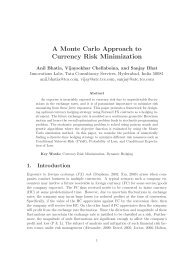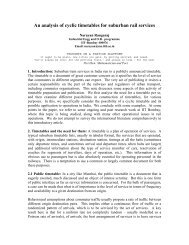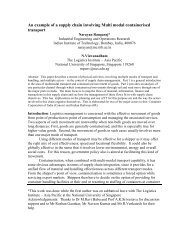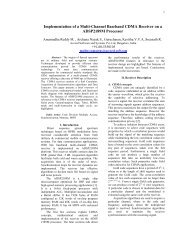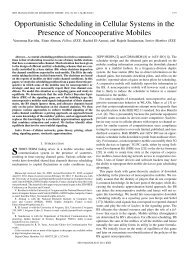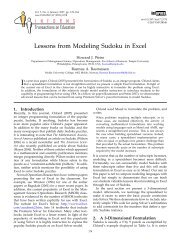Node capacity and terminal management on Indian Railways
Node capacity and terminal management on Indian Railways
Node capacity and terminal management on Indian Railways
You also want an ePaper? Increase the reach of your titles
YUMPU automatically turns print PDFs into web optimized ePapers that Google loves.
where it is accepted that the larger secti<strong>on</strong> cannot h<str<strong>on</strong>g>and</str<strong>on</strong>g>le that number of trains because the intermediate<br />
stati<strong>on</strong> cannot h<str<strong>on</strong>g>and</str<strong>on</strong>g>le that traffic.)<br />
The situati<strong>on</strong> is compounded as far as network <str<strong>on</strong>g>capacity</str<strong>on</strong>g> is c<strong>on</strong>cerned, where it may be accepted that<br />
Bharuch Vadodara <str<strong>on</strong>g>and</str<strong>on</strong>g> Vadodara Godhra may have some secti<strong>on</strong>al <str<strong>on</strong>g>capacity</str<strong>on</strong>g>, but it may well be that<br />
Vadodara yard cannot h<str<strong>on</strong>g>and</str<strong>on</strong>g>le this number. Partly, these difficulties, added to the problems of measuring<br />
n<strong>on</strong>-homogeneous traffic have led to an obscuring of the measurement of some crucial infrastructural<br />
bottlenecks. The issue of defining line capacities for n<strong>on</strong>-homogeneous traffic has been briefly<br />
discussed in Rangaraj <str<strong>on</strong>g>and</str<strong>on</strong>g> Srivastava (2000a) <str<strong>on</strong>g>and</str<strong>on</strong>g> also by the methodology proposed by the L<strong>on</strong>g Range<br />
Decisi<strong>on</strong> Support System (LRDSS) of the <strong>Indian</strong> <strong>Railways</strong> (e.g. see Salhotra (1999)).<br />
As regards node capacities, there are two major difficulties in assessment. One is that a node <strong>on</strong> a<br />
railway network can have traffic of different types <str<strong>on</strong>g>and</str<strong>on</strong>g> a scheduling model of some kind is required to<br />
route the traffic in a safe <str<strong>on</strong>g>and</str<strong>on</strong>g> effective manner. Only then can the <str<strong>on</strong>g>capacity</str<strong>on</strong>g> of the node to h<str<strong>on</strong>g>and</str<strong>on</strong>g>le traffic<br />
be assessed. The sec<strong>on</strong>d difficulty is to establish a numerical measure for <str<strong>on</strong>g>capacity</str<strong>on</strong>g> in the light of the<br />
mixed activities at a node. A number such as the maximum number of trains h<str<strong>on</strong>g>and</str<strong>on</strong>g>led in a given<br />
directi<strong>on</strong> is not adequate, as a measure, as it cannot be translated into effective service measures or used<br />
in judging investment effectiveness.<br />
A possible soluti<strong>on</strong> to this is the following. An answer to the questi<strong>on</strong> "What time delay does a st<str<strong>on</strong>g>and</str<strong>on</strong>g>ard<br />
type of unscheduled freight train face, arriving at a r<str<strong>on</strong>g>and</str<strong>on</strong>g>om point during the day, while passing through<br />
any part of the rail network?" If this answer is c<strong>on</strong>siderably more than the normal free running time of<br />
the train (given its speed characteristics <str<strong>on</strong>g>and</str<strong>on</strong>g> the secti<strong>on</strong>/yard speed restricti<strong>on</strong>s), it can be c<strong>on</strong>cluded that<br />
that part of the network (whether node or secti<strong>on</strong> or a bit of both) is c<strong>on</strong>gested.<br />
Given the line capacities of secti<strong>on</strong>s adjacent to a node, the report by Thoopal (1998) presents a c<strong>on</strong>crete<br />
method to estimate the bottleneck effect of a node. In this, in additi<strong>on</strong> to the platform occupancy charts<br />
of known movements of passenger trains, all possible shunting <str<strong>on</strong>g>and</str<strong>on</strong>g> other movements due to crew<br />
change, loco change <str<strong>on</strong>g>and</str<strong>on</strong>g> other operati<strong>on</strong>s are superimposed. The residual <str<strong>on</strong>g>capacity</str<strong>on</strong>g> <strong>on</strong> platform <str<strong>on</strong>g>and</str<strong>on</strong>g> n<strong>on</strong>platform<br />
lines are used to attempt to h<str<strong>on</strong>g>and</str<strong>on</strong>g>le the freight trains according to some arrival pattern from<br />
neighbouring secti<strong>on</strong>s. This highlights the loss of <str<strong>on</strong>g>capacity</str<strong>on</strong>g> due to the node. The study clearly<br />
establishes the seriousness of the problem in many c<strong>on</strong>gested parts of the <strong>Indian</strong> Railway network <str<strong>on</strong>g>and</str<strong>on</strong>g><br />
suggests a number of c<strong>on</strong>crete measures to address the problem.<br />
3. Classificati<strong>on</strong> of nodes <str<strong>on</strong>g>and</str<strong>on</strong>g> <str<strong>on</strong>g>terminal</str<strong>on</strong>g>s<br />
For c<strong>on</strong>venience, we can describe the <str<strong>on</strong>g>management</str<strong>on</strong>g> of fixed infrastructure facilities in the following three<br />
categories: 1) passenger dominant facilities, 2) freight h<str<strong>on</strong>g>and</str<strong>on</strong>g>ling facilities <str<strong>on</strong>g>and</str<strong>on</strong>g> 3) maintenance oriented<br />
facilities.<br />
Although there could be an overlap of these activities in some facilities, the above provides a useful<br />
classificati<strong>on</strong> of activities, investments <str<strong>on</strong>g>and</str<strong>on</strong>g> strategies that could be followed in each type of facility. The<br />
overlap is a result of a mix of c<strong>on</strong>cerns that are inevitable in activities such as the railways, where<br />
comm<strong>on</strong> facilities are used for a variety of purposes. To that extent, the planning <str<strong>on</strong>g>and</str<strong>on</strong>g> operati<strong>on</strong> of these<br />
facilities cannot be segregated into watertight compartments as far as objectives or strategies go.



